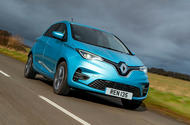The Renault Zoe is no longer on sale because making it comply with GSR2 regulations is too expensive
Twenty technologies now standard on new cars; existing models must comply soon
GSR2 safety regulations have made at least 20 technologies standard on all new cars sold in the EU and the UK – and will legislate some out of existence.
The arsenal of standard safety equipment, brought in under the anonymously titled General Safety Regulations 2 (GSR2), will also add more costs to cheaper cars, likely increasing their prices.
The changes had been in discussion at the UN and the EU for a decade before the EU finalised its proposals in 2019.
They’re being introduced in two main phases. The first went live on 6 July 2023 and the second will come later, in 2024, although some technologies are on a slightly different timetable.
That means all new cars launched after 6 July 2022, regardless of price or engineering suitability, have to comply; and soon, existing cars already on the market will have to be modified or retrofitted to stay on sale.
This retrofitting is what will kill off many cars. For instance, the Renault Zoe has been withdrawn from sale because making it comply with GSR2 regulations would be too expensive. The required safety kit can’t easily be built into the car’s architecture, which was essentially first introduced in 2012. The rules will also restrict Alpine A110 sales.
Insurance industry
The insurance and safety industry, of course, is much more sanguine about the introduction of GSR2.
“This is essentially tidying up existing laws and an update of GSR1, which has been around since 1998, especially since many of these new safety features are already incorporated into existing Euro NCAP [safety] ratings,” said Matthew Avery, boss of UK insurance and safety organisation Thatcham Research and a senior Euro NCAP team member.
The motive behind GSR2 was an EU push to halve the number of road deaths by 2020 and “move close to” zero road deaths by 2050.
The car industry says that it makes safety a priority, but there remains concern within it about the rigidity of the regulations as applied to certain car classes and the EU’s unwillingness to adjust its timetable to fit with model-cycle changes and the global cycle of safety laws.
Ford’s head of homologation, Douwe Cunningham, agreed that there were “no surprises” with some of the technology, such as advanced emergency braking (AEB) and the intelligent speed assistance (ISA) warning system, because they were already part of NCAP.
But there’s a belief that the EU is pushing some of the hardware beyond its reliable use in day-to-day service.
Cunningham raised the question of ISA’s reliability, given that it relies on cameras reading road signs that in many countries are badly maintained, absent and difficult to detect.
The EU regulation also allows for GPS-based speed limit warnings, which rely on perfect mapping accuracy.
Therefore manufacturers that want to make the best offerings for their customers, such as Ford, feel obliged to offer both systems – but on more affordable cars, that means more parts costs added on.
There are also ‘big brother’ elements in the regulations. For example, the driver drowsiness warning will be handled by an in-car infrared camera, always focused on the driver’s face, to detect eye movements.
GSR2 is now on the statute books and therefore a legal requirement, but whether it will actually be effective in reducing road deaths only time will tell.
Standard GSR2 safety tech now standard for all new cars
Advanced emergency braking: Now includes new calibration.
Alcohol interlock: Provision for this until a reliable sensor can be developed.
Driver drowsiness distraction: Will move to advanced infrared camera tech in 2024.
Electronic data recorder: Better known as a black box. Harmonised with US regulations.
Emergency lane keeping system: Steers car away from crossing the road’s central white line.
Intelligent speed assistance: Warns driver of speed limit. Could overrule the driver in the future.
Q&A: Expert engineers from Horiba MIRA
We spoke to three experts from Horiba MIRA: Ashley Patton (ADAS and CAV chief engineer), David Inch (certification and homologation) and Aaron Mandalia (CAV solution leader).
How extensive is GSR2?
“It’s a massive list of 100 or so regulations, depending on vehicle category. Some are amendments, but we’ve identified about 20 to 25 items that are new, where we need to improve our capability out to 2024.”
What’s the aim?
“It’s not inventing a lot from scratch, because many of the features have been around in some form. The EU is trying to create some consistency so that everyone is taking the same approach. That’s welcome.”
How will it affect planning?
“Manufacturers will be debating whether to continue a product by improving it or let it die in July 2024. Those decisions will mostly have been made in strategy, because the timescales aren’t massive.”
How about small cars?
“They’re definitely impacted as high-volume, low-margin vehicles. Adding extra features adds costs, so the manufacturer either has to increase price or consider whether that vehicle is worth selling any more.”
Surely it will be difficult to retrofit features to existing cars by 2024?
“As GSR2 moves to existing products, yes, you probably will see lots disappearing off the market.”
What about integration into the vehicle?
“Manufacturers will have to consider whether it’s worth updating vehicles with older electric architectures, where this technology isn’t fitted because it wasn’t needed for an NCAP safety rating, to comply with GSR2.”
How many vehicle categories are affected?
“It’s not just cars: the ethic of GSR2 is to apply it as widely as possible to as many vehicle categories as they can, so that’s buses, trucks, vans, fire engines – all vehicles, really.”







